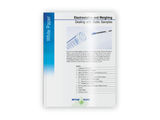Valnoctamide (INN, USAN) has been used in France as an sedative-hypnotic since 1964.[2] It is a structural isomer of valpromide, a valproic acid prodrug; unlike valpromide, however, valnoctamide is not transformed into its homologous acid, valnoctic acid, in vivo.[3]
Additional recommended knowledge
Indications
In addition to being a sedative, valnoctamide has been investigated for use in epilepsy since 1969[4] and was still being investigated in 2000[5] and 2003.
It was studied for neuropathic pain in 2005 by Winkler et al, with good results: it had minimal effects on motor coordination and alertness at effective doses, and appeared to be equally effective as gabapentin.[6]
RH Belmaker, Yuly Bersudsky and Alex Mishory started a clinical trial of valnoctamide for prophylaxis of mania in lieu of the much more teratogenic valproic acid or its salts.[7]
Side effects
The side effects of valnoctamide are mostly minor and include somnolence[8] and the slight motor impairments mentioned above.
Interactions
Valnoctamide is known to increase through inhibition of epoxide hydrolase the serum levels of carbamazepine-10,11-epoxide, the active metabolite of carbamazepine, sometimes to toxic levels.[9]
Chemistry
Valnoctamide is a racemic compound with four stereoisomers, all of which were shown to be more effective than valproic acid in animal models of epilepsy and one of which ((2S,3S)-valnoctamide) was considered to be a good candidate by
Isoherranen, et al for an anticonvulsant in August of 2003.[10]
Notes and references
- ^ Haj-Yehia, Abdullah; Meir Bialer (October 1988). "Pharmacokinetics of a valpromide isomer, valnoctamide, in dogs.". Journal of Pharmaceutical Science 77 (10): 831-4. PMID 3148708.
- ^ (French) HARL, F. M. (March 1964). "[CLINICAL STUDY OF VALNOCTAMIDE ON 70 NEUROPSYCHIATRIC CLINIC PATIENTS UNDERGOING AMBULATORY TREATMENT.]". La Presse Médicale 72: 753-4.. PMID 14119722.
- ^ Haj-Yehia, Abdullah; Meir Bialer (August 1989). "Structure-pharmacokinetic relationships in a series of valpromide derivatives with antiepileptic activity". Pharmaceutical Research 6 (8): 683-9. PMID 2510141.
- ^ (Portuguese) Mattos Nda, S. (May 1969). "[Use of Valnoctamide (nirvanil) in oligophrenic erethics and epileptics.]". Hospital (Rio J) 75 (5): 1701-4. PMID 5306499.
- ^ Lindekens; Ilse Smolders, Ghous M. Khan, Meir Bialer, Guy Ebinger, and Yvette Michotte (November 2000). "In vivo study of the effect of valpromide and valnoctamide in the pilocarpine rat model of focal epilepsy". Pharmaceutical Research 17 (11): 1408-13. PMID 11205735.
- ^ Winkler, Ilan; Simcha Blotnik, Jakob Shimshoni, Boris Yagen, Marshall Devor, and Meir Bialer (September 2005). "Efficacy of antiepileptic isomers of valproic acid and valpromide in a rat model of neuropathic pain". British Journal of Pharmacology. PMID 15997234.
- ^ RH Belmaker, Yuly Bersudsky, Alex Mishory and Beersheva Mental Health Center (2005). Valnoctamide in Mania. ClinicalTrials.gov. United States National Institutes of Health. Retrieved on 25 February 2006.
- ^ VALNOCTAMIDE Biam French.
- ^ Pisani F, Fazio A, Artesi C, Oteri G, Spina E, Tomson T, Perucca E. "Impairment of carbamazepine-10, 11-epoxide elimination by valnoctamide, a valpromide isomer, in healthy subjects." British Journal of Clinical Pharmacology. 1992 Jul;34(1):85-7. PMID 1352988
- ^ Isoherranen, Nina; H. Steve White, Brian D. Klein, Michael Roeder, José H. Woodhead, Volker Schurig, Boris Yagen, Meir Bialer (August 2003). "Pharmacokinetic-pharmacodynamic relationships of (2S,3S)-valnoctamide and its stereoisomer (2R,3S)-valnoctamide in rodent models of epilepsy". Pharmaceutical Research 8 (8): 1293-301. PMID 12948028.
| Anticonvulsants (N03) |
|---|
| Barbiturates | Barbexaclone, Metharbital, Methylphenobarbital, Pentobarbital, Phenobarbital, Primidone |
|---|
| Hydantoins | Ethotoin, Fosphenytoin, Mephenytoin, Phenytoin |
|---|
| Oxazolidinediones | Ethadione, Paramethadione, Trimethadione |
|---|
| Succinimides | Ethosuximide, Mesuximide, Phensuximide |
|---|
| Benzodiazepines | Clobazam, Clonazepam, Clorazepate, Diazepam, Lorazepam, Midazolam, Nitrazepam, Temazepam |
|---|
| Carboxamides | Carbamazepine, Oxcarbazepine, Rufinamide |
|---|
| Fatty acid derivatives | Valpromide, Valnoctamide |
|---|
| Carboxylic acids | Valproic acid (Sodium valproate & Valproate semisodium), Tiagabine |
|---|
| Others | GABA analogs: Gabapentin, Pregabalin, Progabide, Vigabatrin -- Monosaccharides: Topiramate -- Aromatic allylic alcohols: Stiripentol -- Ureas: Phenacemide, Pheneturide -- Phenyltriazines: Lamotrigine
Carbamates: Emylcamate, Felbamate, Meprobamate -- Pyrrolidines: Brivaracetam, Levetiracetam, Nefiracetam, Seletracetam
Sulfa drugs: Acetazolamide, Ethoxzolamide, Sultiame, Zonisamide -- Propionates: Beclamide -- Aldehydes: Paraldehyde -- Bromides: Potassium bromide, Sodium bromide |
|---|
|







